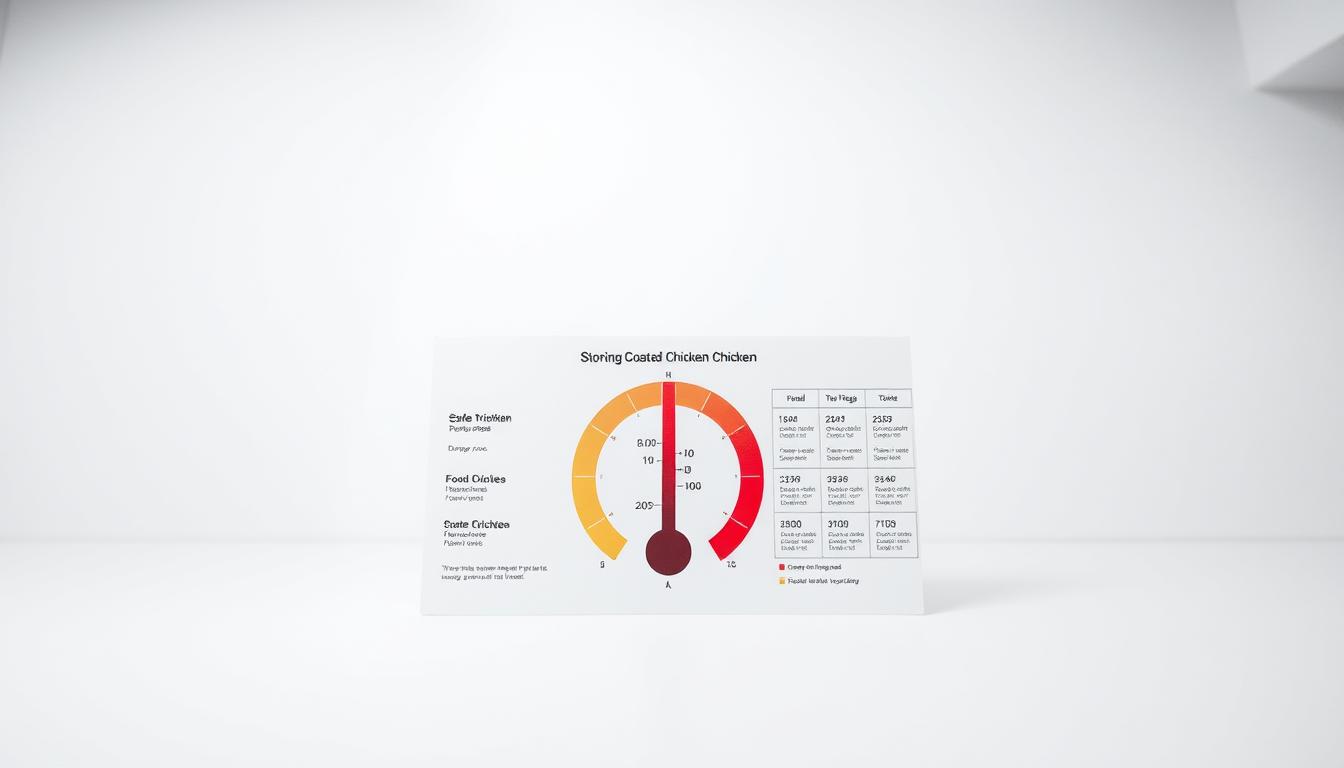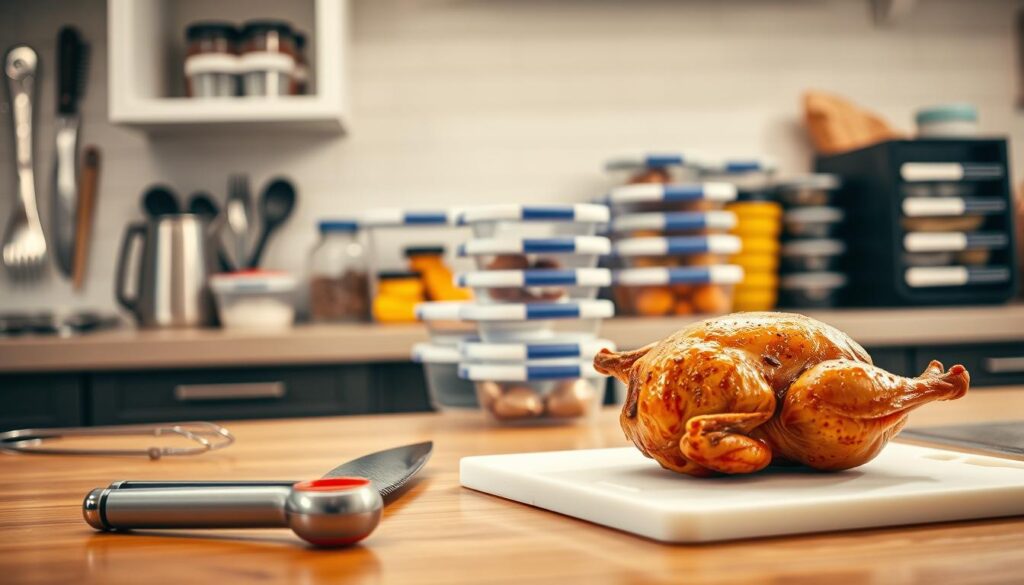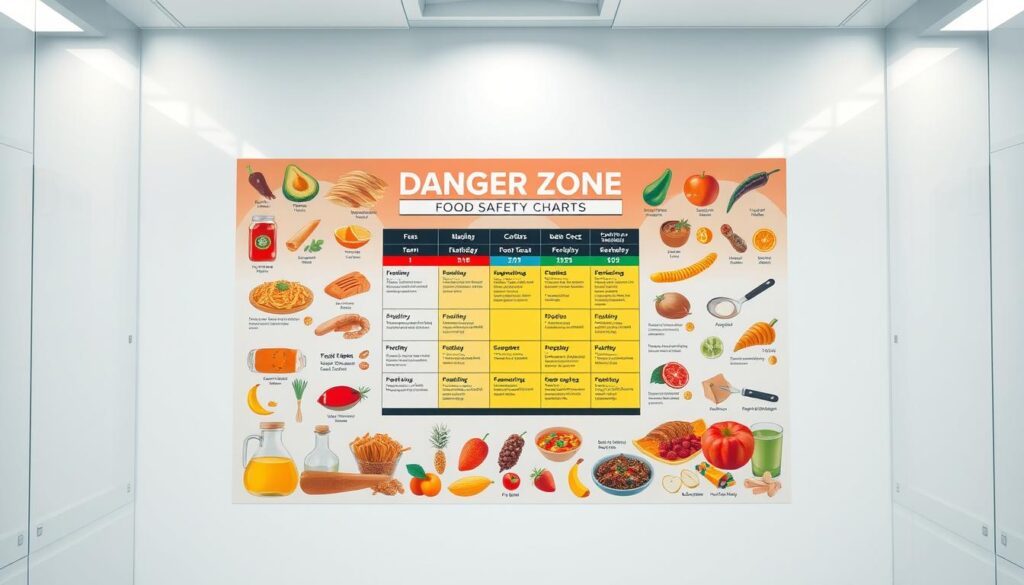
Picture this: you worked hard preparing a delicious meal, only to realize leftovers sat forgotten on the counter overnight. That sinking feeling hits – is it still safe to eat? For many home cooks, this moment sparks real anxiety about food poisoning risks.
Raw poultry naturally carries bacteria like Salmonella and Campylobacter. While cooking kills most germs, improper storage creates new dangers. When food lingers between 40°F and 140°F (the “danger zone”), harmful organisms multiply exponentially. Just two hours in this range can turn your tasty chicken into a health hazard.
This guide gives you science-backed strategies to protect your household. You’ll discover why timing matters more than you think and how simple habits prevent most foodborne illnesses. Let’s explore the facts that keep your kitchen both welcoming and safe.
Table of Contents
Understanding the Temperature Danger Zone
Every year, countless meals become unsafe due to invisible threats in home kitchens. The temperature danger zone acts like a hidden accelerator for harmful organisms, turning leftovers into potential hazards faster than most realize.
Where Risks Multiply Rapidly
Food safety experts define the danger zone as 40°F to 140°F – the sweet spot for bacterial reproduction. In this range, microorganisms like Staphylococcus aureus double their numbers every 20 minutes. A single bacterium becomes over 1 million in just 7 hours.
| Temperature | Bacteria Growth Rate | Safe Duration |
|---|---|---|
| Below 40°F | Slowed or paused | Indefinitely safe* |
| 40°F – 140°F | Exponential increase | Max 2 hours |
| Above 140°F | Growth inhibited | Until cooling begins |
Room Conditions & Microbial Parties
Typical room temperatures (68°F-72°F) turn poultry into a bacteria breeding ground. USDA studies show dishes left out for 90 minutes at 70°F can harbor dangerous pathogen levels. Refrigeration within two hours stops this process cold – literally.
Three critical steps disrupt this cycle:
- Cook meat to 165°F internal temperature
- Divide large portions for faster cooling
- Store in shallow containers in the fridge
These practices create time barriers against contamination. Remember: visual cues like smell or texture changes often appear after harmful levels form. Temperature control remains your primary defense.
Safe Handling and Storage Practices for Cooked Chicken
Your kitchen becomes a food safety fortress when you master proper poultry handling. These battle-tested methods protect your meals from invisible threats while preserving flavor and texture.
Thawing and Cooking Mastery

Always thaw frozen poultry in the refrigerator (24 hours per 5 lbs) or under cool running water. Countertop thawing invites bacteria growth in the temperature danger zone. Cook meat to 165°F internally – use a digital thermometer for accuracy.
| Storage Location | Temperature | Safe Duration |
|---|---|---|
| Refrigerator (raw) | 40°F or below | 1-2 days |
| Freezer (cooked) | 0°F | 4 months |
| Countertop | Room temp | 0 hours |
Smart Refrigeration Strategies
Store prepared dishes on upper shelves, raw meats below. This way prevents drips from contaminating ready-to-eat foods. Divide large portions into shallow containers – they chill faster than deep bowls.
Cross-Contamination Defense
Designate separate cutting boards for meats and produce. Wash hands thoroughly after handling raw poultry – 20 seconds with soap. Sanitize surfaces immediately using a bleach solution (1 tbsp per gallon).
These practices evolved over years of food safety research. When followed consistently, they create multiple barriers against illness while keeping meals delicious and secure.
Room Temperature Timing: how long can cooked chicken sit out?
Timing determines safety when dealing with prepared meals. Those golden-brown pieces might look harmless on your countertop, but microscopic threats multiply rapidly without proper temperature control.

Understanding the Two-Hour Rule and Its Exceptions
The two-hour limit exists because bacteria enter explosive growth phases in the danger zone. Research shows pathogens like Bacillus cereus can produce toxins within 90 minutes at 70°F. This rule applies to most perishable foods, including dairy and eggs.
Exceptions occur when:
- Dishes contain preservatives (like vinegar-based sauces)
- Food stays heated above 140°F in chafing dishes
- Immediate freezing occurs after cooling
Adjustments for Hotter Environments Above 90ºF
Summer picnics and outdoor events require extra vigilance. At 95°F, bacterial populations double every 10 minutes instead of 20. Use this comparison guide:
| Ambient Temp | Safe Duration | Risk Level |
|---|---|---|
| Below 40°F | Indefinite | Low |
| 40-90°F | 2 hours | Moderate |
| Above 90°F | 1 hour | High |
Always err on the side of caution. If you question whether poultry stayed out too long, discard it. Share these guidelines with family to create safer meal habits across your household.
Conclusion
Food safety isn’t about luck—it’s about applying proven steps consistently. Your refrigerator serves as the first line of defense, stopping bacterial growth in its tracks when used within the two-hour rule. These practices work together to create a safety net for every meal.
Maintain order by storing items at proper temperatures immediately after cooking. Keep cooked poultry out of the danger range (40°F-140°F) to prevent rapid spoilage. Divide large batches into shallow containers for faster cooling—this simple habit preserves quality and safety.
Handle leftovers with care: reheat thoroughly and discard anything questionable. Remember, visible signs of spoilage often lag behind actual contamination risks. Trust time limits over appearances.
By mastering these guidelines, you’ll reduce waste and protect your household. Your kitchen becomes a space where safety and flavor work in harmony. Stay vigilant, stay informed, and keep that refrigerator running efficiently—it’s the silent partner in your food protection routine.
FAQ
What temperature range defines the danger zone for poultry?
The temperature danger zone for foods like cooked chicken is between 40°F and 140°F. Bacteria multiply rapidly in this range, increasing spoilage and foodborne illness risks.
Why does cooked poultry spoil faster at room temperature?
At room temp, bacteria like Salmonella or Staphylococcus thrive. These pathogens can double every 20 minutes, making leftovers unsafe within two hours if unrefrigerated.
How soon should you refrigerate leftovers after cooking?
Move poultry to the fridge within two hours of cooking. In environments above 90°F (like outdoor events), reduce this window to one hour to prevent bacterial growth.
Can reheating chicken make it safe after sitting out?
Reheating won’t always neutralize toxins produced by bacteria during spoilage. Follow the two-hour rule strictly, and discard food left beyond this timeframe.
What’s the safest way to store poultry for later use?
Use shallow airtight containers to cool cooked chicken quickly. Store in the refrigerator at 40°F or below for up to four days, or freeze for longer-term safety.
How does cross-contamination affect cooked chicken safety?
Raw poultry juices can transfer bacteria to cooked food via utensils or surfaces. Always use separate cutting boards and wash hands thoroughly to avoid contamination risks.

